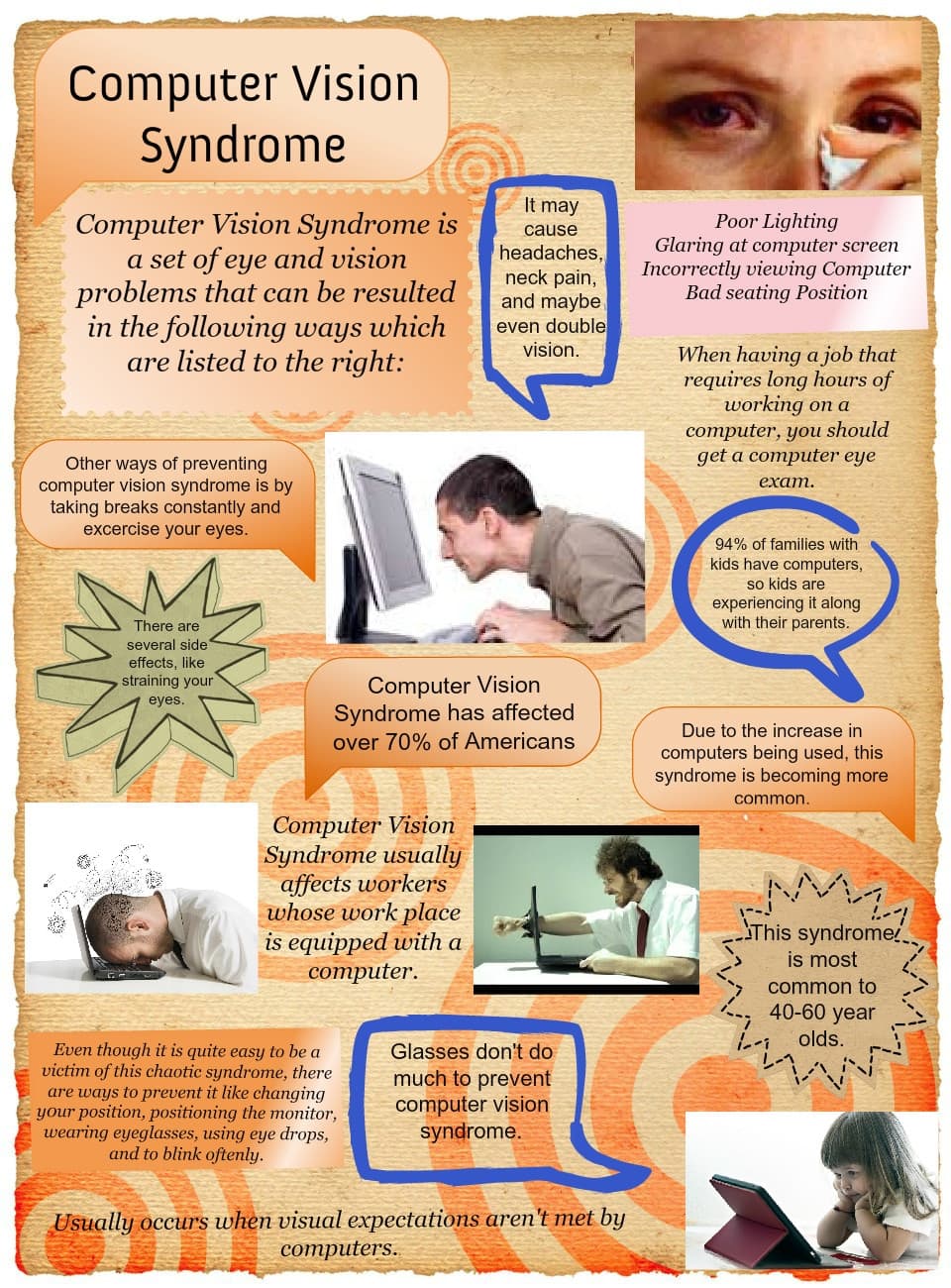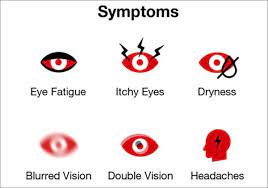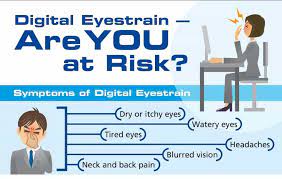https://philaholisticclinic.com/computer-vision-syndrome/
Computer vision syndrome
Computer vision syndrome is a group of eye and vision problems. Problems can include eyes that itchy and watery and become dry and red. Your eyes may get tired or uncomfortable. You may not be able to concentrate normally. These problems are caused by too many computers or the use of digital devices. Using electronic readers and smartphones can also cause these problems.
These problems have increased in frequency in recent decades. Many people experience some symptoms if they use a computer or digital device for long periods of time. Most computer or digital device users experience symptoms at least a few times. Digital eye strain is very common in children and adults.

Computer vision syndrome, also known as digital eye strain, describes a group of eye and vision problems that result from prolonged use of computers, tablets, e-readers, and cell phones.
Many people experience eye discomfort and vision problems when watching digital screens for long periods of time. The level of discomfort seems to increase with the amount of use of the digital screen.
The average American worker spends seven hours a day on the computer, whether in the office or working from home. To help alleviate digital eye strain, follow the 20-20-20 rule; take a 20-second break to see something 6 meters away every 20 minutes.
Causes & Risk Factors
Looking at a computer or digital screen often makes your eyes heavier. As a result, the unique properties and high visual demands of computer and digital screen viewing make many individuals susceptible to developing vision-related symptoms. Uncorrected vision conditions can upsurge the harshness of Computer vision syndrome (CVS). Viewing a computer or digital screen is different from reading a printed page. Oftentimes, the letters on the computer or handheld device are not as precisely or sharply defined, the contrast of the letters with the background is reduced, and the presence of glare and reflections on the screen can make viewing difficult.

The distances and viewing angles used for this type of work are also often different from those commonly used for other reading or writing tasks. As a result, the focus and eye movement requirements for digital screen viewing may place additional demands on the visual system. In addition, the presence of even minor vision problems can often significantly affect comfort and performance on a computer or when using other digital display devices. Uncorrected or under-corrected vision problems can be major contributors to computer-related eye strain. Even people who have a prescription for glasses or contact lenses may find it inappropriate for the specific viewing distances of their computer screen. Some people tilt their heads at odd angles because their glasses aren’t designed to look at a computer, or they lean toward the screen to see it clearly. Their postures can lead to muscle spasms or pain in the neck, shoulders, or back.
What causes Computer vision syndrome?
For many reasons, reading text on a computer screen or digital device is often more difficult on the eyes than reading printed text. This is why working on a computer for a few hours can cause symptoms of Computer vision syndrome, but not reading a book.
Several factors contribute to causing digital eye strain, such as:
- Screen glare
- Low lighting
- Poor posture when using a computer
- Looking at a computer from the wrong distance and angle
- Uncorrected vision problems
- A combination of several of these factors
People often blink less when using a computer than when reading printed text. This can cause dry eyes, which can contribute to digital eye strain.
In most cases, symptoms of computer vision syndrome arise because the visual demands of the task exceed the individual’s visual abilities to perform them comfortably. People who spend at least two consecutive hours in front of a computer or using a digital screen device each day are at the greatest risk of developing compucter vision syndrome.
Symptoms of CVS
The most common symptoms associated with Computer vision syndrome or digital eye strain are:

- Eye strain.
- Blurred vision.
- Itchy eyes
- Dry eyes.
- Neck and shoulder pain.
- Tears in the eyes
- Double vision
- Eye discomfort
- Eye fatigue
- Blurred vision
- Eye redness
The degree to which people experience visual symptoms often depends on their level of visual ability and the amount of time they spend watching a digital screen. Uncorrected vision problems such as

farsightedness and astigmatism, lack of focus or eye coordination, and age-related eye changes such as presbyopia can contribute to the development of visual symptoms when using a computer or digital screen device.
Many of the visual symptoms experienced by users are only temporary and will diminish after stopping working on the computer or using the digital device. However, some people may experience reduced visual abilities, such as blurred distance vision, even after they stop working at a computer. If nothing is done to address the cause of the problem, the symptoms will continue to recur and possibly worsen with the future use of a digital display.
Diagnosis of computer vision syndrome

Computer vision syndrome, or digital eye strain, can be diagnosed through a comprehensive eye exam. Testing with a special focus on visual requirements at the working distance of the computer or digital device can include:
- Medical history to pinpoint all of the patient’s signs and the existence of any overall health conditions, medication taken, or environmental influences that may contribute to signs associated with the use of a computer.
- Visual acuity measurements to assess the extent to which eyesight can be impaired.
- A refraction to determine the appropriate lens power required to compensate for refractive errors (nearsightedness, farsightedness, or astigmatism).
- Evaluating how the eyes focus on subjects, move, and work along. To get a clear, consistent picture of what is being seen, the eyes must effectively change focus, move, and work in unison.
This test can be done without the use of eye drops to determine how the eyes react under normal visual conditions. In some cases, e.g. B. if part of the focusing power of the eyes is obscured, eye drops can be used. They temporarily prevent the eyes from changing focus during the test. Using the information from these tests and the results of other tests, an optometrist can determine the presence of computer vision syndrome or digital eye strain and recommend treatment options.
Who is at risk for digital eye strain?
You may be at greater risk of computer vision syndrome if you:
- Spend several hours a day at a computer or digital device.
- Are too close to the screen of your computer or digital device
- Look at your computer or digital device from the wrong angle
- Poor posture when using a computer or digital device
- Vision problems (even minor ones) that cannot be corrected with glasses or contact lenses.
- Have glasses that are not suitable for viewing from your computer’s distance.
- Take no breaks while working
You may have an underlying dry eye problem. This can lead to a worsening or greater likelihood of computer vision syndrome. Dry eye is more common in women than in men. It also becomes more common with age. Certain medications and health problems increase the likelihood of dry eyes. For example, if you are taking antihistamines, you may have an increased risk of dry eye. If you have a thyroid disorder or certain autoimmune diseases, you are also at greater risk for dry eye.
Important points about computer vision syndrome
- Digital Eye Strain is a group of related vision and vision problems caused by prolonged use of computers or digital devices.
- Symptoms include eye discomfort and fatigue, dry eye, blurred vision, and headache.
- The main cause is uncorrected vision problems.
- Sometimes hidden health problems help with this.
- A better computing environment can help ease symptoms.
- Resting your eyes regularly is one of the best ways to prevent and manage computer vision syndrome.
Treatment for computer vision syndrome.
The solutions to vision problems associated with a digital screen are varied. However, they can usually be alleviated by regular eye care and changes to the look of the screen.
In some cases, people who do not need to wear glasses for other daily activities may benefit from glasses that are prescribed specifically for use at the computer. In addition, people who already wear glasses may find that their current prescription does not provide optimal vision for computer viewing.
- Glasses or contact lenses prescribed for general use may not be suitable for computer use. Lenses may be required to suit the unique visual requirements of computer viewing. Special lens designs, lens strengths, shades, or coatings can help improve visual performance and comfort.
- Some active users of computers experience problems with focusing on subjects or eye coordination that cannot be adjusted with glasses or contact lenses. A vision therapy program may be required to treat these specific problems. Vision therapy, also called visual training, is a structured visual activity program designed to improve visual performance. It trains the eyes and brain to work together more efficiently. These eye exercises help fill deficits in eye movement, eye focus, and eye synergy and strengthen the connection between the eye and the brain. Treatment can include both office and home teaching procedures.
- Glasses or contact lenses prescribed for general use may not be suitable for computer use. Lenses may be required to suit the unique visual requirements of computer viewing. Special lens designs, lens strengths, shades, or coatings can help improve visual performance and comfort.
Viewing the computer

Correct posture is very important when you are working on the computer. Some vital aspects in prophylactic or decreasing the severity of CVS symptoms are related to the type of computer, type of monitor, and the way it is used. This includes lighting conditions, seating comfort, location of reference materials, monitor position, and use of rest breaks.
- The location of the computer screen. Most people find it more comfortable to work with a computer when their eyes are down. Ideally, your computer screen should be 15-20 degrees below eye level (about 4-5 inches), measured from the center of the screen and 20-28 inches from your eyes.
- Reference materials. These materials should be placed above the keyboard and below the monitor. If for whatever reason you can’t organize your workplace this way, a document holder can be placed next to the monitor. The goal is to position the documents so that the head does not have to move from document to screen.
- Position your computer screen to avoid reflections, especially from light or windows. Use blinds or curtains on windows and replace lamps in table lamps with low voltage ones.
- Chairs should be comfortably padded and conform to the shape of the body. The height of the chair should be adjusted so that the feet are flat on the floor. The arms should be adjusted to provide support when typing and the wrists should not rest on the keyboard when typing.
- Rest breaks. To avoid eye strain, try resting your eyes when using the computer for long periods of time. Rest your eyes every 15 minutes for at least 1 minute while staring at a computer monitor. In addition, every 20 minutes of computer viewing, look into the distance for 20 seconds to allow the eyes to refocus.
- Turn signal. To minimize the chance of developing dry eyes when using a computer, try blinking frequently. Blinking keeps the front surface of the eye moist.
Regular eye exams and correct viewing habits can help prevent or reduce the development of symptoms associated with cardiovascular disease.
Prophylactic of computer vision syndrome.
Preventing or reducing vision problems associated with computer vision syndrome or digital eye strain involves taking steps to control the lighting and glare on the device screen, establishing working distances and posture appropriate for on-screen viewing, and ensuring that even minor vision problems are properly corrected.
Suggestions for those who suffer from computer vision syndrome.
- Don’t take your eyesight problem to work. Even if glasses aren’t needed for driving, reading, or other activities, they can still offer benefits for a minor vision problem that worsens computer use. A mild prescription for glasses may be needed to reduce visual stress at work. It is a good idea for computer users to undergo a thorough eye examination each year.
- The glasses should meet the requirements of the work. If glasses are worn for distance vision, reading, or both, they may not provide the most effective vision on a computer screen that is approximately 20 to 30 inches from your eyes. Inform the doctor about professional tasks and measure eye distance in the workplace. Accurate information will help you get the best vision improvement. Patients can take advantage of one of the new lens designs specially designed for computer work.
- Minimize the discomfort caused by blue light and glare. Blue light from LED and fluorescent lighting, as well as monitors, tablets, and mobile devices, can negatively affect vision in the long term. Special lens shades and coatings can reduce the harmful effects of blue light. Minimize glare on your computer screen by applying a glare reduction filter, repositioning the screen, or by using curtains, blinds, or blinds. In addition, keeping the screens clean; dirt-free, and anti-fingerprint can reduce glare and improve clarity.
- Customize the workspace and computer for convenience. When using computers, most people prefer a work surface height of around 26 inches. Desks and tables are typically 29 inches high. Place the computer display between 16 inches and 30 inches. The upper edge of the monitor should be to some extent below horizontal eye level. Tilt the top of the screen from 10 to 20 degrees.
- Use an adjustable copyholder. Place the reference material at the same eye distance as the computer screen and as close to the screen as possible. That way your eyes won’t have to shift focus when looking from one to the other.
- Take alternative breaks from tasks throughout the day. Make calls or photocopies. Consult with your coworkers. After working at the computer for a long time, do anything where your eyes don’t need to focus on something up close.
Natural treatment for computer vision syndrome
Diet for Computer Eye Strain
As SUNY College of Optometry researchers noted in a study described in my video, Dietary Treatment for Computer Eye Strain, the increase in computer screens “has led to an increase in eye and vision problems, including eye discomfort, blurring of distant objects, eyestrain, and asthenopia (eye fatigue). ” This caused the so-called “quasi-labor-induced transient myopia”. That’s when, after looking at the computer screen for a while, we look out the window and things start to get blurry. Our vision blurs because our poor ciliary muscles pulling on our lenses are locked in this constant state of contraction to maintain close focus. Over time, this can have long-term adverse consequences.

A double-blind, placebo-controlled, crossover study, for example, found a significant improvement in refraction values and eye fatigue symptoms when subjects ate blackcurrant compared to a placebo.
However, what passes for gooseberries in the US are usually champagne raisins, not real blackcurrants, which were banned in the US a century ago by order of the lumber industry. The lumber industry feared that they might spread a plant disease that affects white pine (which we hardly harvest anymore). However, the blackcurrant is back (and the ban has been lifted in some states), although any anthocyanin-rich berry can have similar benefits (such as blueberries, blueberries, cranberries, black raspberries, and red raspberries).
Why bother with whole blueberries or gooseberries when we could just take anthocyanin supplements? Because, as we’ve seen repeatedly when we test supplements, we’re lucky if they actually contain what’s listed on the label. Moreover, even for foodstuffs containing blueberries, one study found that tagging used to be useless, misleading, or both, something for which the herbal supplement market is infamous. The largest study to date has found that most herbal supplement labels appear to lie.
Blueberry rose to prominence during World War II when it was said that British RAF pilots “ate blueberry jam to improve their night vision.” It turns out that this could have been a story invented to deceive the Germans. The real reason why the British were able to suddenly attack Nazi bombers in the middle of the night, even before the bombers reached the English Channel, was probably not because of blueberries, but because of a top-secret new invention that the British needed to store in secret: radar.
For best results when it comes to eye strain, consume whole berries with blue and red pigments and remember to give your eyes a break every hour.
Yoga and exercise for computer vision syndrome
If you regularly experience symptoms such as eye strain, blurred vision, headache, increased sensitivity to bright light, tired eyes, or difficulty maintaining alertness, you may want to do certain eye exercises, such as:
Blinking every three or four seconds for about a minute helps reduce eye strain by cleaning the cornea and allowing the eyes to rest.

Palms of the eyes – This is achieved by gently pressing three fingers on each hand against the upper eyelids for a few seconds and then releasing them. Repeat this process at least five times to release tension in the ciliary muscles of the eye.
Focusing on a Distant Object – Pick an object six to ten meters away from you and focus on it for about twenty seconds without moving your head. This gives rest to the ciliary muscles, which we normally put under heavy strain when we focus intensely on the computer screen.
To strengthen the eye muscles, close your eyes and roll your eyeballs around for a minute.\
Traditional Chinese Medicine – an effective treatment for computer vision syndrome
A common Chinese herbal drink for eye strain is a tea made with goji berries and chrysanthemum flowers in lukewarm water.
Goji berry is a Chinese herb that helps nourish the eyes and provides hydration and Yin to the eyes. In fact, these berries contain the antioxidant zeaxanthin which helps protect the eyes from age-related diseases.

Chrysanthemum flowers are another Chinese herb. In traditional Chinese herbal medicine, this herb helps reduce heat, wind, and nourish eye yin, which is perfect for dry itchy eyes.
Goji and chrysanthemum tea is excellent for eye strain after long hours of staring at screens. This tea is very pleasant because it is sweet, aromatic, and as a bonus contains many antioxidants. When adding the flowers to the hot water, they will split open and look like they are blooming.
Acupuncture – ancient Chinese treatment for computer vision syndrome
Acupuncture offers a natural approach to improving vision and relieving the pain that is often associated with visual impairment.
If you suffer from any type of eye or vision problem, acupuncture may be a viable option for relieving symptoms and restoring eye health. Chinese medicine has been shown to improve ophthalmological problems by up to 56% in recent studies, including cases of glaucoma.

By improving ocular blood flow, acupuncture can improve everything from vision to limiting vision loss, especially in older patients. Based on the result of TCM evaluation, our acupuncture practitioners will determine the most sensitive and active acupoints in your body to reach to improve eye well-being in a safe and natural way.
Most acupuncture treatments last 60 minutes. The duration of the actual treatment is 25-40 minutes, depending on the case. Since each case is unique, the exact number of treatments is difficult to estimate. However, on average, most patients receive between 10 and 30 treatments. Patients with eye diseases are seen very often at the beginning.
The most common initial changes are higher brightness, better sharpness, and a wider field of view. Given that there are many different types of eye conditions, it is difficult to say exactly how each person benefits from them. About 80% of clients notice changes within the first 10 treatments.
Clinical studies proved the effectiveness of acupuncture for computer vision syndrome.
Homeopathic remedies for computer vision syndrome
Homeopathic medicines are very beneficial in treating computer vision syndrome. These drugs help manage the symptoms of computer vision syndrome and provide relief. Symptoms of computer vision syndrome, including dry and red eyes, blurred vision, eye strain, tired eyes, eye irritation, eye burns, double vision, headaches, and Neck pain can all be wonderfully managed with natural medicines. The main drugs listed that help manages symptoms of computer vision syndrome include Ruta, Belladonna, Physostigma, Euphrasia, and Gelsemium.

Argentum nitricum: complaints of overwork. The muscles around the eyes get tired. The patient feels better with eye closure or pressure. Aggravated by overheating. A good remedy for restoring the strength of a weakened ciliary muscle
Arnica: Constant close focusing makes the eyes sore. Fatigue due to overwork. The patient wants to open his eyes and feels dizzy when closing them. Back pain from overexertion.
Ruta: the main remedy for eye strain due to excessive stress on the eye muscles. The patient has watery eyes, increased sensitivity to light. Stiffness and pain will ultimately lead to headaches. The patient feels pressure behind the eyeball. Difficulty focusing the eye.
Conium: Artificial light or fatigue causes eye strain. Photophobia. incorrect night vision. When the brain falls asleep, the patient has a sensation of a foreign substance. Worse at night. Better, pressure and darkness in the room. Seeing a black spot of fatigue. Headache with shooting pain in vertex, one-sided.
Natrum muriaticum: Continuous reading or schoolwork leads to a weak feeling of pressure in the eye, muscle stiffness around the eyeball. Eyelids feel heavy and eventually, the person complains of a headache. The person feels like letters converge on the screen. Constant typing on the computer leads to numbness and tingling in the fingers. A person can’t hold things. Back pain is relieved by putting hard things under the back.
Thuja: Good remedy for cramps in the fingers. Fingertips ended hard. Feel dead
Crocus Sativa: patient complains of constant blinking after eye strain and reading a lot
Euphrasia: Problems begin after continuous eye work. Watery eye. Burning and swelling of the eyelids. Sticky mucus on the cornea, causing the patient to blink frequently
Kalmia latifolia: stiffness of the eyelids. aggravated by moving eyes. Low vision or poor eyesight with nerve pain in the face, teeth. Joint or muscle stiffness. Move from place to place.
Conclusion
At the Philadelphia Holistic Clinic licensed medical professional working under the strict supervision of internationally recognized integrative medicine specialist, Victor Tsan, MD. At the clinic, we have all holistic modalities and you can get the best customized specifically for your holistic treatment for computer vision syndrome.
To schedule your appointment for evaluation contact the clinic at (267) 284-3085 or use our online secure application
Comments
Post a Comment